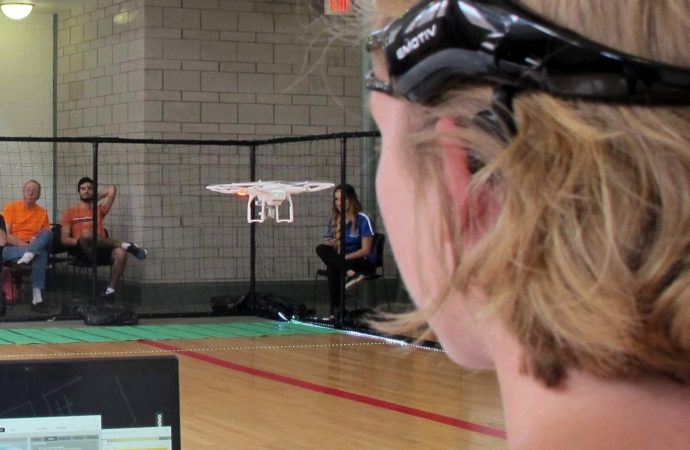‘Once I know what the readings look like from your brain in a certain situation, I’ll be able to recognize you by that pattern again later on,’ neuroscientist warns amid rise of computers that can read our minds.
Wearing black headsets with tentacle-like sensors stretched over their foreheads, the competitors stare at cubes floating on computer screens as their small white drones prepare for takeoff.
“Three, two, one … go!” the announcer yells. And, as the racers fix their thoughts on pushing the cubes, the drones suddenly begin to whirr, rise and buzz through the air. Some struggle to move even a few feet, while others zip confidently across the finish line.
The competition — billed as the world’s first race for drones controlled by people’s thoughts — involved 16 pilots flying drones over a course of just 10 yards in an indoor basketball court at Florida University.
The Associated Press was there to record the event, which organizers hope to make an annual inter-collegiate spectacle, involving ever-more dynamic moves and challenges.
“With events like this, we’re popularizing the use of BCI [brain-computer interface] instead of it being stuck in the research lab,” said Chris Crawford, a PhD student in human-centered computing.
“BCI was a technology that was geared specifically for medical purposes, and in order to expand this to the general public, we actually have to embrace these consumer brand devices and push them to the limit.”
Scientists have been able to detect brainwaves for more than a century, and mind-controlled technology already is helping paralyzed people move limbs or robotic prosthetics. But now the technology is becoming widely accessible. Emotiv and NeuroSky are among the start-up companies offering electro-encephalogram (EEG) headsets for purchase online for several hundred pounds. The models used by the Florida racers cost about $500 (£350) each.
The system works by using an EEG headset that has been calibrated to identify the electrical activity associated with particular thoughts in each wearer’s brain — recording, for example, where neurons fire when the wearer imagines pushing a chair across the floor. Programmers write code to translate these “imaginary motion” signals into commands that computers send to the drones.
Professor Juan Gilbert, whose computer science students organized the race, is inviting other universities to assemble brain-drone racing teams for 2017, pushing interest in a technology whose potential seems limited only by the human imagination.
As our lives become increasingly reliant on internet-enabled devices, a concept known as the ‘internet of things’, Professor Gilbert and his team want to know how mind-controlled devices could expand and change the way we play, work and live.
Unlocking a car or exploring a virtual world could one day be tasks achieved by thought alone. It could also be applied for real-time monitoring of our moods and states of consciousness. Researchers are studying whether they can use a lorry driver’s mind to trigger a device that will tell him when he’s too tired to drive.
“One day you could wear a brain-controlled interface device like you wear a watch, to interact with things around you,” Professor Gilbert said.
So far, BCI research has largely been about helping disabled people regain freedom of movement. Recently, an Ohio man using only his thoughts was able to move his paralyzed hand thanks to a chip implanted in his brain. In Miami, doctors using BCI are helping a 19-year-old man stand on his own after losing the use of his legs in a motorcycle accident.
The idea of collegiate brain-drone races pleases Dr Bin He, a biomedical engineer at Minnesota University who first demonstrated a mind-controlled drone in public in 2013.
“The progress of the BCI field has been faster than I had thought ten years ago,” he said. “We are getting closer and closer to broad application.”
But as the technology moves toward wider adoption, ethical, legal and privacy questions remain unresolved.
The US Defence Department — which uses drones to kill suspected terrorists in the Middle East from vast distances — is looking for military brain-control applications. A 2014 Defence Department grant supports the Unmanned Systems Laboratory at Texas University, San Antonio, where researchers have developed a system enabling a single person with no prior training to fly multiple drones simultaneously through mind control.
In this system, instead of the pilot thinking certain thoughts to move the drones, she looks at a screen with flickering signals, triggering brain activity that translates into specific movements. “It can accommodate lots of commands, much more than imaginary motion can,” researcher Yufei Huang said.
But enthusiasts should think carefully before they hand over their brainwaves for purposes that have yet to be conceived or contained, said Kit Walsh, a staff attorney at the Electronic Frontier Foundation with a degree in neuroscience from the Massachusetts Institute of Technology.
“EEG readings are similar to fingerprints: once I know what the readings look like from your brain in a certain situation,” she said. “I’ll be able to recognize you by that pattern again later on.” (AP)
Source: Independent

































Leave a Comment
You must be logged in to post a comment.